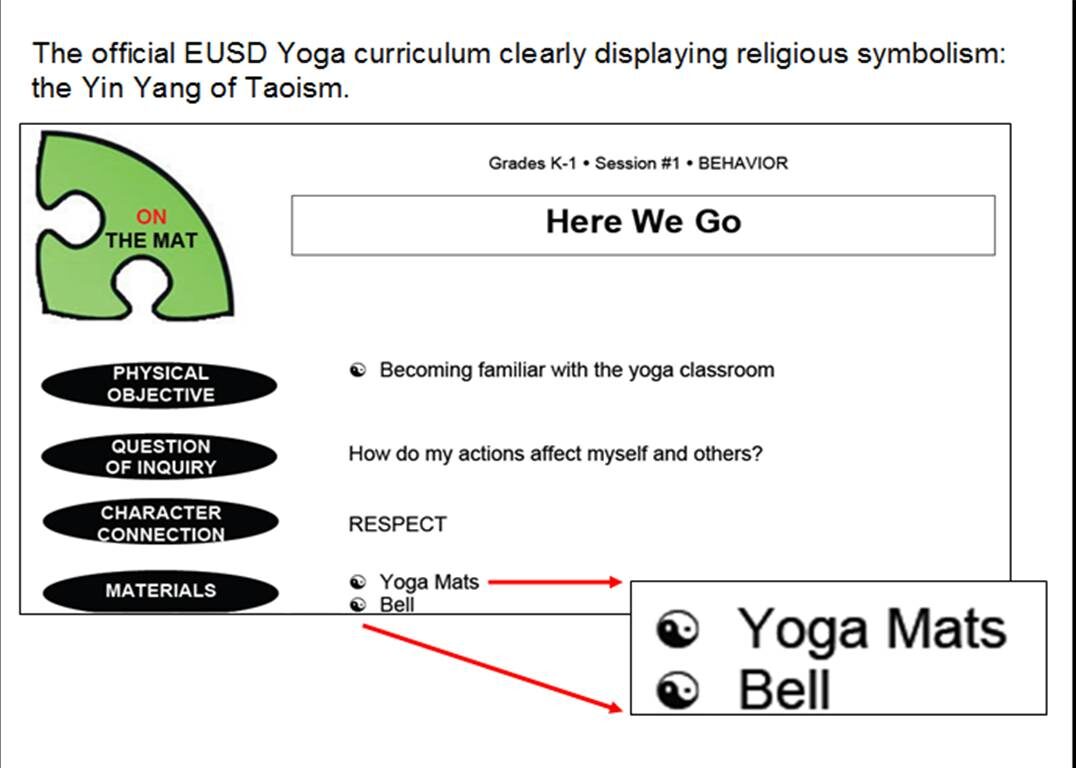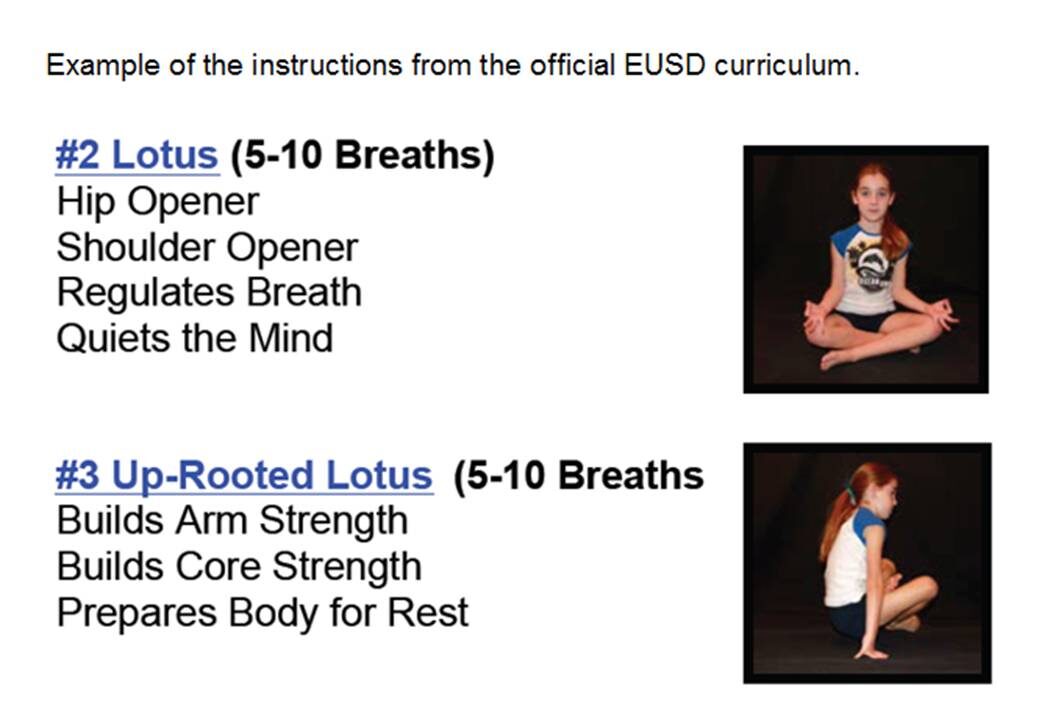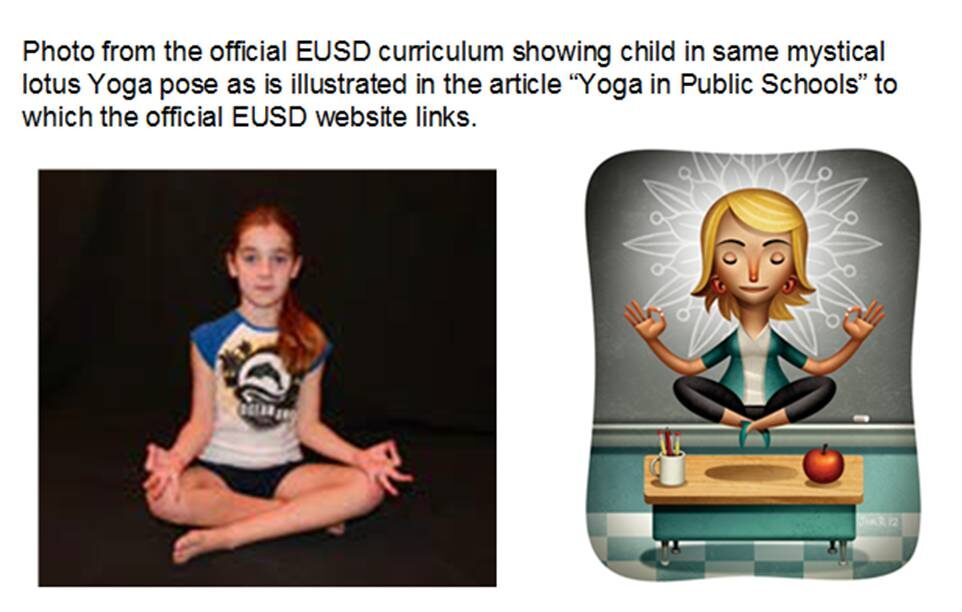We now conclude, from part 1 and part 2 wherein we described what Yoga is, considering the issue of Yoga in public schools. This issue has come and gone at since circa the 1960s and has arisen again via the Encinitas United School District in California (the EUSD).
On the EUSD’s official website you will find, “EUSD Yoga and Wellness Study – Parent Questionnaire” and “EUSD Yoga and Wellness Study – Student Survey (Grades 3-6)” yet, access to these requires a password.
However, they do provide some info for public consumption. For example, in part 2 of this series we considered the text of the article Yoga in Public Schools which is from Tolerance Magazine and which is linked to from the official EUSD website. We will now consider the actual content of the actual Yoga curriculum which is in the page titled, “EUSD Health & Wellness Program” and subtitled as “We are proud to present a sample of the curriculum we are currently developing…” (ellipses in original).
Just as a note on navigation in case you find yourself on the main EUSD page. Their website is found here:
There is a “button” at the lower right part of the page which states, “Health and Wellness” which is hyperlinked to:
http://eusd.net/Parents/SitePages/health%20and%20wellness.aspx
That link leads to a page wherein there is a circular jigsaw puzzle illustration on of the parts of which states, “ON THE MAT” which links to their curriculum which is found here:
http://eusd.net/Parents/health%20and%20wellness/On%20The%20Mat.pdf
Upon opening the PDF curriculum file one instantly notes various Yin Yang symbols. This really is enough to conclude that they are pushing religion within tax payer funded public schools.
Granted, whoever placed them there does not exactly know what they are doing because the Yin Yang symbol is indicative of Taoism whilst Yoga in Hindu. Although there is a relation since the Indian Hindu Bodhidharma brought systems of meditative manipulation of chi (aka qi, prana and…the force) which were incorporated into Taoism and thus form the premise of energy manipulation based martial arts in the form of Qi Gong / Chi Kung, etc. But such details will be left to a future article on martial arts and energy work.
The curriculum (© EUSD 2012-13 Grades K-1) is for, “Becoming familiar with the yoga classroom” and note that it is grades K-1 meaning that they begin at kindergarten—right off the bat, the minute they walk into public school.
The “BUILDING BACKGROUND” section sates the purpose(s) as:
…connect more deeply with their inner selves, and develop an understanding with the natural world that surrounds them.
You may have thought that public schooling was about learning reading, writing, math, history and science so when did we get to having tax payer funded public schools teach connecting to inner selves and understanding the natural world (in a non-geological/scientific manner but spiritually)? Sadly, when you point out to many parents that Yoga is religious they are actually quite pleased and want their (and yours and mine) tax payer dollars to fund it in public schools.
This sort of curriculum is turning our public schools into centers of mystical initiation wherein they mystically connect with their inner selves and engage in Pagan Gaia (Earth) worship.
The curriculum states:
The simple breathing exercises involved with yoga help children relax by focusing on their breath and the simplicity of the moment. A yoga session is not complete without the final resting pose. This allows the body to take time to understand the new information it has received through practicing yoga.
The final resting pose is further defined as follows:
Every yoga session will end with the Lotus positions. Like a lotus flower floating on the surface of the water, these positions symbolize a sense of calm reflection, and tranquility in the body.
Three lotus positions are prescribed and these are:
#1 Folded Lotus (5-10 Breaths) #2 Lotus (5-10 Breaths)
#3 Up-Rooted Lotus (5-10 Breaths)
The imagery of the lotus flower is not just having fun floating around but the opening up of the flower which is the opening up of the mind and body of the Yoga practitioner so that they are open wide for whatever is poured into them, “the new information it has received through practicing yoga.”
Another section has as its goal, “Learning to respect the yoga classroom” which simply sounds odd; kids are to respect a classroom? This is their indoctrination into considering the classroom as a sacred space wherein they enter to gain enlightenment.
And no sacred space is complete without a spiritual leader. But there is no such thing in public schools—right?:
To begin to get students familiar with some basic poses, play a simple game of Yogi Says.
In this case Yogi is not the name of a cartoon bear (although it makes you wonder why he was given that name) but rather the term for a practitioner of Yoga. Thus, the kids are taught to respect their sacred site and obey their yogi, their spiritual leader.
Another goal is, “Learning to respect the practice element of yoga” and so they are to revere, have respect for, the sacred space, their Yoga instructor and Yoga itself. They are also to be told that, “Yoga takes time to learn” which, recall, is being told to kindergarteners who are being put on a lifelong path of Yoga and thus, Hindu enlightenment.
In part 2 we demonstrated that many people seeking to push Yoga into the public schools attempt to fool people who do not know any better by hiding the “yogic nomenclature.”
Well, the official EUSD is not so shy:
Using the actual names of the poses will help familiarize students to yoga terms for later sessions.
One of the practices for the kids is to:
Lie down on your back…Allow your eyes to sink to the back of your head…Let go of the thoughts in your mind and we will stay here resting in stillness and silence for a few more moments…come back to a cross leg position…How do you feel right now? Does your body feel different than when you entered the class today?
To let go of thoughts is to teach detachment from the body and mind and as noted in part 1, this is precisely the religious purpose of Hindu Yoga. The kids are asked to give feedback, to recognize that regardless of what anyone says about religion in public schools the ends justify the means and so if it feels good, do it. They are being encouraged to develop a positive correlation between how they feel and Yoga—will the math teacher ask the kids how they feel after that class?
It is specified that, “Breathing evokes the relaxation response inside the nervous system.” Forget how wonderful this sounds of a moment and realize what they are stating; they seek to manipulate your children’s central nervous system.
There is so much in the curriculum that many people who would even bother to attempt to discern would not know how to interpret. For example:
Direct students to sit naturally and inhale deeply. Observe what happens to the body. Ask for student responses. Explain that the spine lengthens on the inhale and contracts on the exhale.
Again, they are not only being told what to do but are asked for feedback that will validate that which they are doing. But more importantly, and much more esoterically, they are to be told about how “the spine lengthens on the inhale and contracts on the exhale.” The hidden point behind this is what is known as the raising of the kundalini which is a major point in Yoga.
Kundalini is the serpent energy which is said to be wrapped around the base on the spine. The point of just about every occult practice—by any other name—is to get the serpent to slither its way up the spine and end up in the skull, in the brain, where it takes control of the person. In Hindism this takes the form of seeking to activate the chakras (energy nodes) that are said to line up from the base of the spine to the top of the head. The activation of the serpent energy is very, very dangerous particularly to the uninitiated, as it were, and can lead to hallucinations, disorientation, and many much worse things.
Much emphasis is placed on the mind within the curriculum and this is a selling point for how to make Yoga acceptable in public schools. However, it is emphasized within the curriculum because it is emphasized in Hinduism practice of Yoga (in its various forms).
The school will emphasize the mind as having something to do with calmness and learning. However, as elucidate in part 1, Yoga emphasizes the mind as a vehicle for getting the immaterial soul to disconnect from the material body—this is why the Yoga poses are so extreme; to get the mind to not think of itself as the body and to evolve in Hinduism’s spiritually.
The curriculum encourages to “focus the mind and bring mastery to the individual poses” and in a section titled, “Connecting Breath with Sound” notes:
Guide the students as follows: When we’re practicing yoga, we always breathe in through the nose and out through the nose. We want the breath to make a soft sound like the sounds of the ocean waves as the come and go from the shore. It’s kind of like whispering “haaa” with your mouth closed.
Let’s try this. Take a deep inhale and as you exhale, whisper “haaa”. Inhale again, this time with the mouth closed, “haaa”. Let’s see if we can get the same sound on the inhale. Try imagining inhaling the scent of a sweet flower…Take a few deep breaths and remember how it felt last time to breathe with sound.
Again, this would be difficult to understand by those unlearned in this area so let us review. The reason to make a sound, or imagine one, whilst breathing is that it causes are resonant effect. That is to say that it stimulates the body, perhaps mostly the pineal gland, and focusing on monotonous repetition puts one in an altered state of consciousness via getting into a certain frequency of vibration and thus, one becomes hyper-suggestible to whomever, or whatever, is attempting to get at, or in, them.
Why else would student who are in tax payer funded public schools to use their minds be told to, “Let go of the thoughts in your mind”? By letting go on their own thoughts, those of someone, or something, else are able to take their place.
To last points. One is an actually positive practice with the Yoga curriculum:
Compliment Circle – Have students sit in a large circle. Go around the circle and have each student take a turn giving a compliment about the person sitting next to them until each student has heard something positive about themselves.
Although this Examiner is not in the least bit approving of the self-esteem movement it is refreshing that in schools where teasing and bullying are the modus operandi that kids would take the time to be nice to each other.
Via this they are to:
Identify ways to work and play well with others.
Demonstrate appropriate social and classroom behavior.
Yet, even in this there is are two issue to consider: 1) Yoga is utterly unnecessary for student to sit around and say nice things to each other and 2) Yoga is being used as a moral guide.
Secondly, and lastly, for whatever reason the book “Tacky the Penguin” by Helen Lester is recommended as an optional text to be used for within the Yoga class.
Let us consider what Barnes and Noble comments about this book:
Tacky is an odd bird who marches to the beat of his own drummer. He’s something of an eccentric, which wouldn’t be a problem if all the other penguins weren’t such . . . conformists. Helen Lester and Lynn Munsinger have teamed up to tell Tacky’s story, about the day when some hunters come to the penguins’ Nice Icy Land, and how Tacky’s individuality saves the day!
Amazon.com quotes the following in their description:
From Publishers Weekly None of the penguins can tolerate Tacky’s loud habits–until they scare off a pack of hunters. PW declared that “this book is must reading for any kid–or grown-up–who refuses to follow the pack.” From School Library Journal
Kindergarten-Grade 2 Tacky the Penguin is a total nonconformist who lives with a group of formal, proper penguins. But it is Tacky who foils the plans of three critters with “get-rich-quick plans” that threaten the penguins’ existence. With his un-penguin-like antics, Tacky puzzles the hunters to such an extent that they’re firmly convinced they cannot be in the “land of the pretty penguins.” This is a rollicking tale that clearly shows that there are ad vantages to being an individual. Munsinger cheerfully captures the mood of the tale with her whimsical, full-color illustrations that are particularly strong in depicting the hunters’ determined, then befuddled, expressions and Tacky’s madcap antics. This is sure to elicit lots of chuckles from young readers.
Lastly, what the curriculum itself has to say. The kids are asked to discuss:
How was Tacky different from the other penguins? How did Tacky feel about his differences? Was Tacky afraid of the hunters? How did being different help Tacky save all the other penguins? Do you think the other penguins thought differently about Tacky after he saved them? Is being different okay?
Have you ever felt different?
What does any of this have to do with Yoga? From this vantage point perhaps what is being encouraged is to disregard that some will (rightly) oppose Yoga in public schools (maybe even their very own parents).
Now, at schools which are supposed to function via classes and which are supposed to prepare one for the workforce, children are being asked to not be part of the class but to be individualistic and different.
On the surface there is nothing wrong with that but society does have a certain drum beat via which we can all get along, at least conceptually. But they are being encouraged to beat their own drums. Thus, conformists (formal, proper penguins) are to be looked down upon. Hunters are the bad guys as are capitalists (hidden under the concept of get-rich-quick) who corrupt the Nice Icy Land and concludes in how Tacky “saved them.”
The question is not whether conformity or individuality is better; the question is that a public school is taking it upon itself to determine which is better and to teach your children, from kindergarten, which one is better.
Yes, being different is okay and everyone has at one point or another felt different. Yet, we all know very, very well that within public schools kids today are being encouraged to follow their every whim and feeling—to include very, very early age feelings of sexuality.
Here are some relevant books:
Knowing the Facts about Yoga by John Ankerberg and John Weldon
Should Christians Practice Yoga? by John Weldon
A DVD: Yoga Uncoiled From East to West by Caryl Matrisciana
For more info see the following videos:
Yoga as Christian Occult Practice by Caryl Matrisciana
The Yoga Boom: What are Christians to do? by Elliot Miller
For more background and consideration of some Hindu philosophy see the video:
Bill Honsberger – Hinduism and Advaita Vedanta: the Roots and Fruit of a Movement




